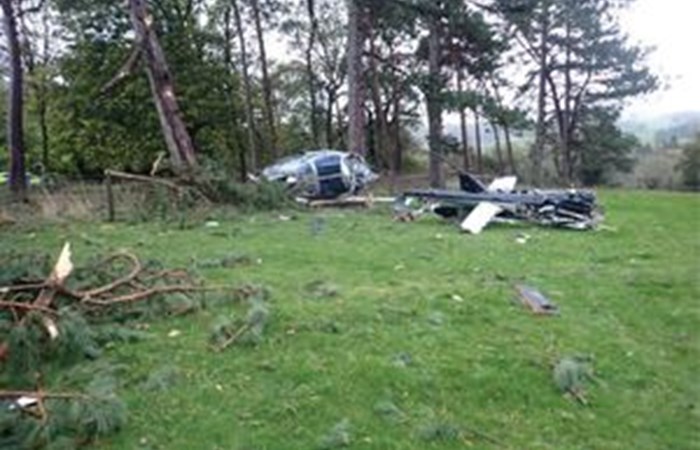Air Accidents Investigation Branch

While climbing away from an unlit field landing site, at a height of approximately 40 ft agl, G-RAYNs main rotor blades struck trees and sustained catastrophic damage. The helicopter fell to the ground, coming to rest on its right side. The fuel tanks maintained their integrity and there was no fire. The pilot was able to shut down both engines and, with the assistance of onlookers, helped the passengers to escape from the cabin. One of the passengers was seriously injured in the accident. Of the five passengers, at least four had not fastened their seatbelts prior to departure.
No causal or contributory technical factors were identified with the helicopter during the investigation. The investigation found that the accident resulted from the unintended rearward transition of the helicopter into a stand of trees during a planned vertical departure at night from an unlit field landing site. The flight had been scheduled as a day departure but the takeoff became delayed until after nightfall.
The investigation found several operational barriers which might have prevented this accident but were either breached or not present. These included a misunderstanding of the applicable operator-level restrictions for the non-revenue flight being undertaken and opportunities missed during the planning process to anticipate and mitigate for flight delays.
Distraction and time pressure led to the pilot not completing auditable weight and balance (WB) calculations before leaving Biggin Hill, this potentially contributed to the helicopter being overweight when it took off on the accident flight. While the pilot had assessed the available lighting as sufficient for the intended takeoff profile, the visual cues available to him on the night proved inadequate for the detection of the subsequent unintentional rearward drift toward the trees behind the helicopter.
The passengers did not exert any pressure on the pilot to delay beyond the planned departure time, and the pilot did not consider that a night departure would pose an unacceptable risk.
The investigation thought it likely that, had all passengers been secured by their seat harnesses, the level of injuries sustained could have been less severe. For frequent flyer passengers, or those focused on time pressures, it might be tempting to see safety briefings and seatbelts as an unnecessary encumbrance. In helicopters with seating and cabin configurations like G-RAYNs, once pilots are in their seats, it is not possible for them to visually check the security of their passengers seatbelts/harnesses. Nonetheless, it is important for all parties to understand that an aircraft commander is under a legal obligation to ensure passengers are appropriately briefed and have their harnesses secure for all takeoffs and landings.
While the pilot carried out a strategic pre-flight risk assessment, a more effective and targeted tactical Threat and Error Management (TEM) approach to each phase of the operation could have provided an additional safety barrier for the flights being undertaken.
Following the accident safety action has been taken by the operator to improve its night flying procedures, ground equipment and training.
